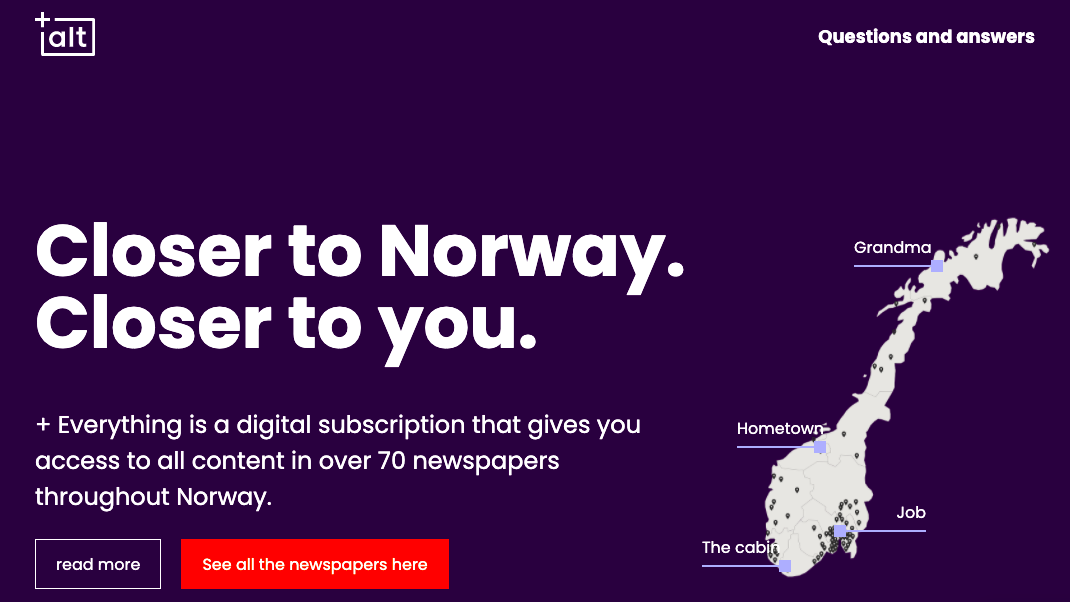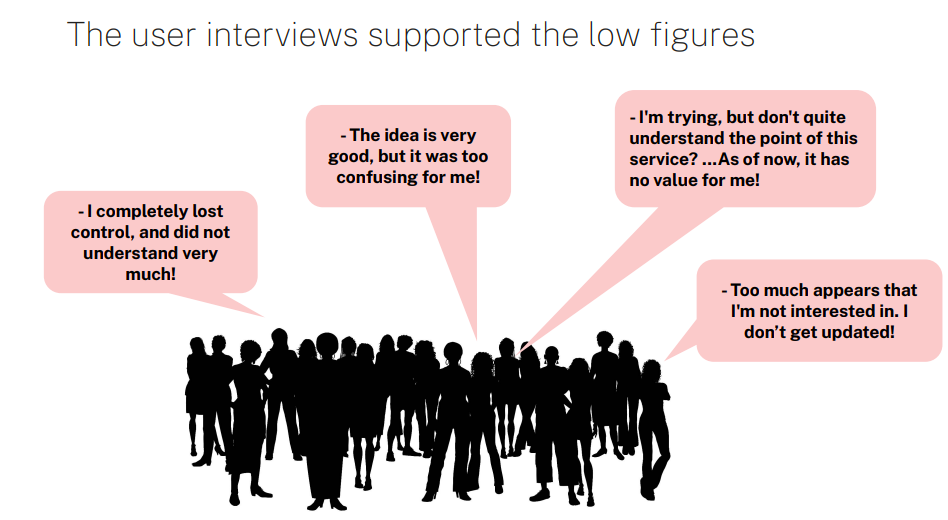
Newsletter
Newsletter
What happens when you launch a product and users find it confusing? Amedia shows how to iterate until you get it right.
18th May 2023

In the Pugpig weekly media bulletin, Pugpig’s consulting services director Kevin Anderson and digital growth consultant James Kember distill some of the best strategies and tactics that are driving growth in audiences, revenue and innovation at media businesses around the world.
It isn’t everyday that your audience tells you the new product or service that they want from you, but Norway’s Amedia, which publishes 100 titles across the country, heard from their readers that they wanted access to more than just the newspaper title where they lived. At WAN-IFRA’s recent Digital Media Europe conference, Amedia’s head of product Ole Werring could relate to readers having ties and interests in many parts of the country. He was born in Bergen in the southwest but grew up and went to university in Trondheim before moving to the north for his first job and eventually landing in Oslo.
That led to the launch of Alt+ six years ago. The service allowed subscribers to buy a subscription to access content across their titles. They launched the service during the pandemic as a free upgrade, although they eventually planned to charge an additional fee for this new all-access tier. Initial uptake handily beat expectations, but they quickly discovered that dissatisfaction with the new product.
They didn’t know how many people would be interested in the product, but Werring said one colleague said he would shave his head if they got more than 50,000 requests to upgrade. I guess he was handed a razor because 51,000 signed up in the first 24 hours and within two months, they had 170,000 users.
Their audiences were clearly interested, but the product team smartly did not simply rely on the numbers and conducted interviews with users and did guerrilla user testing, filming how they used the product. While people liked the idea of access to several titles, in practice they said that found the new subscription product hard to use. They were interested in places but didn’t necessarily know the name of the newspaper title in those locations.

Fortunately, these interviews also gave the product team ideas about how to refine the product. Alt+ subscribers wanted news from these various places in one place, not spread over all of the sites in Amedia’s network. And they wanted the service to be personalised to help them discover stories that they might be interested in. For services like this, it’s been our experience that audiences are often interested in locations, but they are also interested in topics regardless of location.
Instead of trying to re-architect all of their sites, they built a single platform for the merged content and added 1000 news articles to it every day while also adding an archive of similar content as well. After building the content, they returned to testing, and this is one of the great lessons of the project, how to test and refine a product. They chose retention as their key quantitative signal of user value, but they really leaned into qualitative data with usability test, user interviews, purchased surveys and guerrilla testing, taking the product into public places and testing it with users.
Again, the initial results were disappointing based on the retention metrics. Only 10% of users returned after the first week, and that dropped to 8% after the second week. They concluded that they had actually failed with the first version of the product. And that’s a tough point for product teams: Do you continue to refine the product or retire it? When do you call time on a new product and decide that you’ve invested enough time, effort and money to test the idea but aren’t seeing enough of a return or enough success to continue to invest?
The interviews found that the new version of the product suffered from the same issue as the first: It was too confusing. They decided to use a three-day design sprint to identify user ‘pain points’ and how they might solve them. They rebuilt the entire service, splitting it into two areas, a home area focused on locations that they wanted to follow and a second ‘discover feed’ where they offered a personalised stream of content from the country that they might be interested in.
They created the new version in three to four weeks, demonstrating an agility to their execution, and this time, they got positive feedback from users. But before declaring victory, they wanted to see if the numbers supported the qualitative feedback. Retention was four times higher in week one than the first version, 45.5% versus 20.8%, and more than eight times higher in week six, with a retention rate of 43.3% versus 5.2%. Result! They launched the product last month, April, with a monthly subscription pricing of NOK 299 or about €25.60.
The case study provides a number of excellent lessons for new product development:
And most of all, this case study demonstrates the patience and perseverance to get a product right.
This week an article in the A Media Operator (AMO) blog caught our eye with its bold headline: “The Platform Era is Dead. Long Live The Homepage!”
The central theme relates to something we touched on recently when we used this instalment of the Media Bulletin to analyse the fall of Buzzfeed. Social media companies, particularly Facebook, have de-prioritised news within their sites and are trying instead to keep users within their own platforms. AMO highlighted data compiled by Charbeat and presented in the Press Gazette that’s worth quoting here:
For 1,350 global publishers included in Chartbeat’s data, 27% of page views coming from external, search and social in January 2018 came from Facebook (2 billion page views). In April 2023, this was down to 11% (1.5 billion).
Of course, there’s always a chance that the platforms could pivot back to news. It was a commercial decision made by Meta in summer last year to focus on creator content and should it not work out, they may reverse course. However, technical developments are indicating, to the AMO at least, that the direction of travel is moving away from news sites. They point to that whilst AI is being increasingly integrated into platforms, its approach is to learn and leave “providing the knowledge to readers without needing to direct people to the publications”.
Despite this, there is still hope in the publishing industry that the large-scale audience driven revenue streams can work. The Messenger’s launch and target of $100m in revenue is evidence of this. However, AMO is scathing of the plan, describing it as “preposterous” and “not going to happen”. It’s going to be difficult without Facebook.
While this isn’t the end of digital media, it is a significant pivot. The days of relying on the search or social “side door” to drive content are over, but that’s ok. Those audiences that came through from the platforms were always unlikely to subscribe anyway, and given the current advertising climate, it is hard to monetise loosely connected readers. What matters going forward is building a strong brand with good content that resonates with users and builds relationships that drive regular engagement.
However, a suggestion that this is going back to the media landscape before platforms isn’t accurate. Publishers now have a huge array of tools to make their digital products better and more engaging and these simply didn’t exist in the pre-Facebook early 2000s.
Whilst publishers can no longer expect social platforms to drive traffic there are still ways to reach new users. Search remains a key driver for many of the media brands we work with and it hasn’t seen the same drop off as Facebook, Twitter and LinkedIn. A robust SEO strategy that ensures content is discoverable is still essential to media brands. Of course the use of AI presents a challenge, and the way SEO functions will change, but it’s unlikely to result in a total pivot away from news. That being said, vigilance is key.
The difference between the pre-platform era and the current state of the industry is that it is now relatively easy to quickly understand how users are engaging with content on a relatively deep level. The temptation is often to look at page views, but as we mentioned last week a shift to other metrics, such as ‘regularity’ is a lot more important to understand audience value.’ This means that publishers are well positioned to ensure that their content is not just original and well-researched but to understand what works with their own audience.
With traffic no longer easy to replace, it is more important than ever to reduce user churn and increase audience engagement. Once a reader has visited the site, media companies need to focus on strategies that build habit and loyalty. The Independents A2k strategy is one example of this. By encouraging users to register they are giving themselves a contact point to re-engage those readers after they leave the platform, without needing to rely on external platforms. This allows them to develop deeper relationships with their readers.
A strong audience engagement strategy also needs an optimised product experience to build strong connections with your audiences. At Pugpig we see the benefits that apps have as a way to build habit and loyalty with an audience, whilst features like push notifications offer a way to keep audiences engaged. If publishers continue to build responsive and engaging platforms, they will hold their own in the battle for attention with social platforms and be well placed to retain more of their existing users.
The platforms shift away from news is not a threat but an opportunity. At Pugpig Consulting we’re working with partners to build great products that help to achieve engagement and regular use. If you would like to discuss how we can help you, get in touch.
Here are some of the most important headlines about the business of news and publishing as well as strategies and tactics in product management, analytics and audience engagement.

Newsletter

Newsletter

Newsletter

Newsletter

Newsletter